
Andy Lloyd's Dark Star Blog

Blog 29 (August 2015)
Massive Aurora Discovered on an Exo-Brown Dwarf
A brown dwarf, which lies less than 20 light years away in the constellation Lyra, has been found to have enormous aurorae displays, a million times stronger than the northern lights of Earth, and a remarkable 10,000 times stronger than the gas giant Jupiter (1). The light from the reddish aurorae was observed in the visible spectrum, as well as in the X-ray spectrum, and varied considerably with the rotation of the brown dwarf, known as LSR J1835 + 3259 (2).
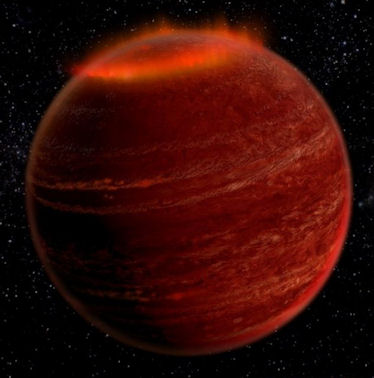
Image Credit: Chuck Carter/Greg Hallinan/Caltech
Unlike the aurora effects generated on planets in the solar system, whose magnetic fields interact with charged particles from the Sun, it is not entirely clear how these powerful aurora displays on the brown dwarf come about, as the M-type brown dwarf has no parent star bombarding it with these charged particles. Most likely, a planet/moon in fairly close proximity to the brown dwarf is driving the process, as the tiny volcanically active Galilean moon Io does within Jupiter's magnetosphere. But this effect on the brown dwarf surpasses that observed on Jupiter by several orders of magnitude:
"Whereas the magnetic activity
of stars like our Sun is powered by processes that occur in their lower
atmospheres, these aurorae [on LSR J1835 + 3259]
are powered by processes originating much further out in the
magnetosphere of the dwarf star that couple energy into the lower
atmosphere. The dissipated power is at least four orders of
magnitude larger than what is produced in the Jovian magnetosphere,
revealing aurorae to be a potentially ubiquitous signature of
large-scale magnetospheres that can scale to luminosities far greater
than those observed in our Solar System."
(3)
The astronomers who have studied this brown dwarf display think that an
Earth-sized planet orbiting within 20 radii of LSR J1835 + 3259 is
capable of generating a current sufficient to power the observed aurorae.
Extrapolating from their results, they think it likely that aurorae may
be present at detectable levels on even the faintest T and Y dwarfs,
which bodes well for searches for similar emission from exoplanets (3).
In other words, the fairly dramatic emission of X-rays from brown dwarf aurorae could provide astronomers with a new way of spotting these
notoriously well-hidden failed stars. It is interesting to note in
this regard that LSR J1835 + 3259 was itself only discovered quite
recently, despite its relatively close proximity to the solar system, by
a non-professional astronomer scouring through the publicly-available
digitised sky surveys (4).
The implications of this discovery are quite profound
for my Dark Star Theory (5,6). The discovery of very strong
aurorae on the free-floating exo-Brown Dwarf LSR J1835 + 3259 creates a
precedent for a smaller cousin which might lie undiscovered in the outer
reaches of our solar system. If brown dwarfs can produce these
dramatic red light effects independent of a parent star, then a
sub-brown dwarf Planet X body might well be capable of producing similar
light effects in the outer solar system. All that seems necessary
to produce this effect is the presence of an Earth-sized planet
orbiting in relatively close proximity to the sub-brown dwarf acting as
a dynamo ploughing through its strong magnetic field. Such a
terrestrial planet/moon, also warmed considerably by its proximity to
the sub-brown dwarf, would be lit by the sub-brown dwarf's aurorae out
in the darkness of space. This lighting and warmth could,
therefore, provide a homeworld capable of sustaining life in the outer
solar system. Furthermore, if this system were to pass close by the
planetary zone of the solar system during a perihelion passage,
specifically skimming across or through the charged boundary known as
the heliopause, then I confidently predict that the extent of this
aurora effect would be magnified considerably, quite possibly leading to
a visible appearance of the sub-brown dwarf itself during perihelion.
The red aurorae would be considerable, swept back into the shape of
wings by the solar wind, and thus creating the famous 'Winged Disk'
effect of Nibiru. Written by Andy Lloyd, 30th July 2015 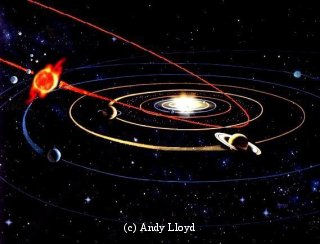
References:
1) Rebecca Morelle "Aurora found around brown dwarf beyond our Solar System" 30 July 2015
2) "LSR J1835+3259"
3) G. Hallinan, et al. "Magnetospherically driven optical and radio aurorae at the end of the stellar main sequence" Nature: 523, 568–571, 30 July 2015
4) I. N. Reid, et al. "Meeting the Cool Neighbors. IV. 2MASS 1835+32, a Newly Discovered M8.5 Dwarf within 6 Parsecs of the Sun" The Astronomical Journal, 125(1):354, December 2007
5) A. Lloyd "The Dark Star Theory" 1999
6) A. Lloyd "Dark Star: The Planet X Evidence" Timeless Voyager Press 2005
Dark Star: The Planet X Evidence
~~*~~
The following is related correspondence from Al Cornette, author of 'Seven Mountains and the Red Star'
"Andy, I felt I must inject my "two cents" into the discussion. It has become more evident that plasma plays a huge role in space:
"Voyager 1 has been traveling for about one year through plasma, or ionized gas present in the space between stars - - - some effects from our sun are still evident."
nasa.gov/mission_pages/voyager"I believe we should better understand what the above statement declares - and that is: all space is filled with varying degrees of plasma concentrations. A planet (brown dwarf) does not need a nearby star like our sun to produce a "luminous" glow. It can glow without being blasted by charged particles from a sun. What causes the glow around the leading edge of an airplane wing in flight - St Elmo's Fire? What causes the "firing up" (glow) around comets too far out in space to be effected by solar heat? Yes, charged particles for the sun can cause luminous events such as comet glow, but we must consider the electrical nature of stars AND planets, and the nature of space filled with varying densities of ionized particles regardless of distances to a neighboring star. Although minimal in some areas, and dense in others, all space between stars and planets are permeated with plasma - "far reaching diffuse clouds of ionized particles." Electromagnetic forces dominate over gravity in deep space.
"This means that stars moving through varying densities of particles (remember NASA's "bubble" were are entering) will react accordingly and fluctuate in their increase or reduction of output. Of course, mainstream science ignores such possibilities as it contradicts red shift, the big bang, and the expanding universe theories. It's a new ball game we're playing in space and the rules have changes. I suspect the hidden agenda behind our "black budgets" know the truth of such matters. We shall see."
Al Cornette, 2nd August 2015
'Frozen primordial soup' found on Comet 67P
After some difficulties associated with its initial positioning on Comet 67P (1,2), ESA's Philae lander has returned data from the comet confirming that its surface is rich with organic compounds. The potential for life to be transmitted to planets via comets (one possible mechanism among several which fall under the umbrella of the 'panspermia theory' (3)), has been a controversial idea for a very long time.
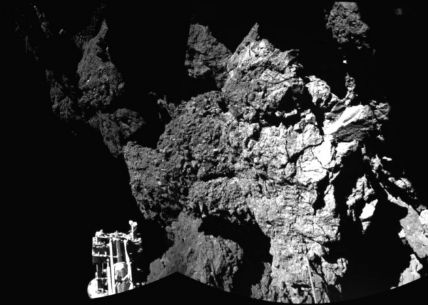
ESA's image of the Philae landing site on Comet 67P
This new data will allow scientists to study their first cometary 'primorial soup', the necessary precursor for the emergence of more complex chemistry (4), and potentially life:
""An instrument on board the small robotic laboratory Philae which landed on the comet 67P/Churyumov-Gerasimenko last November has detected an organic polymer with a similar composition of carbon, hydrogen and oxygen found in the biological molecules of living organisms. The finding is further evidence in support of the theory that comets may have deposited the building blocks of life on the surface of the early Earth some 4.5bn years ago, effectively creating the “primordial soup” that kick-started evolution said Ian Wright, a planetary scientist at the Open University.
"“What we are looking at here is frozen primordial soup and we believe that life evolved from something called primordial soup, but the trouble is it no longer exists on Earth. This comet’s primordial soup has been frozen for about 4.5bn years,” Dr Wright said. “We have long speculated about the composition of comets but now we can put some names to the compounds that are actually there and it helps to explain how comets may have contributed to the organic compounds that they may have brought to Earth. The ratio of carbon, hydrogen and oxygen in this compound is the same as in many important compounds used in living organism, such as ribose sugar which is used to make biological molecules such as DNA and RNA.”" (5)
It's interesting that this news comes quickly on the heels of the recent discoveries about the re-fashioned surface of the unexpectedly active planet Pluto (6), sent back by NASA's probe New Horizons. If simple chemical organic compounds are in place on comets in the outer solar system, essentially frozen in time for 4.5 billion years, and more complex chemistry is apparent on the reddened surface of Pluto, then it stands to reason that a much larger Planet X body (or sub-brown dwarf system) would provide a viable habitat for far more complex chemistry, and/or biochemistry, to take place in the outer solar system.
Written by Andy Lloyd, 30th July 2015
References:
1)
A. Lloyd "The Mystery of Comet 67P" 14 November 2014andylloyd.org/darkstarblog20.htm
2) A. Lloyd "The Asteroid/Comet Identity Crisis" 19-20th December 2014
andylloyd.org/darkstarblog21.htm
3) "Panspermia and the Origin of Life on Earth"
4) A. Lloyd "Life Started on Mars?" 2 September 2013
andylloyd.org/darkstarblog06.htm
5) Steve Connor "Philae lander data show comets could have brought 'building blocks of life' to Earth" 30 July 2015
6) A. Lloyd "Puzzling Pluto Reveals its Secrets" 14-26 July 2015
andylloyd.org/darkstarblog28.htm
New Horizons and the Pioneer Anomaly
"Hello Andy,
Maybe you can convince the John Hopkins observatory to use the new Pluto satellite (sic) [i.e. New Horizons] to look for Nibiru if you give them the coordinates you think it is at. The satellite is still close to Pluto.
Daniel"
Correspondence from Daniel Klimov, 13th August 2015
~~ * ~~
Hi Daniel,
It's unlikely that this probe would be able to spot Planet X.
They've been trying to pick a Kuiper Belt Object to visit with the probe, and have been scanning the skies in its vicinity for years using Hubble, and other telescopes. The probe itself simply doesn't have the power and capability for the job. Saying that, what will be interesting is whether New Horizons encounters the same anomalous slowing of its trajectory that was experienced by the Pioneer probes (but, curiously, not the Voyagers). I think this has something to do with the Dark Star gravitational tug on the solar system.Andy
Lloyd, 15th August 2015See
: "Trouble with Pioneer" in my book 'Dark Star: The Planet X Evidence" pp245-7, 2005 Timeless Voyager Press.
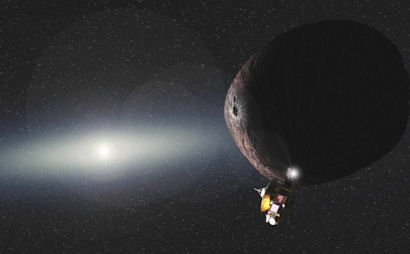
The latest scientific thinking about this long-standing anomaly is that it is caused by a thermal effect: It is thought that the probes essentially emit heat in a non-uniform way, providing a small by significant acceleration in one direction. There are some issues with this, in particular why the effect is only observed once probes are beyond Saturn, and why the effects can be periodic, rather than generally continuous.
The Origins of Sedna
Sedna is a curious red-coloured dwarf planet, a rare and rather strange occupant of the so-called scattered disk beyond the Kuiper Belt (1). Its discovery by astronomer Dr Michael Brown in late 2003 sparked great controversy back, due to the object highly unusual orbit (2).
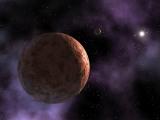
That controversy rages on, with competing theories being put
forward to explain the elongated orbits of Sedna and other extended SDOs
down the years. Many of them involve the influence of an unseen
companion:
"The trans-Neptunian planet hypothesis has been advanced in several
forms by a number of astronomers, including Rodney Gomes and Patryk
Lykawka. One scenario involves perturbations of Sedna's orbit by a
hypothetical planetary-sized body in the inner Oort cloud. Recent
simulations show that Sedna's orbital traits could be explained by
perturbations by a Neptune-mass object at 2,000 AU (or less), a
Jupiter-mass (MJ) at 5,000 AU, or even an Earth-mass object at 1,000 AU.
(3,6) "Computer simulations by Patryk Lykawka have suggested that Sedna's orbit may have been caused by
a body roughly the size of Earth, ejected outward by Neptune early in
the Solar System's formation and currently in an elongated orbit between
80 and 170 AU from the Sun. (7) Mike
Brown's various sky surveys have not detected any Earth-sized objects
out to a distance of about 100 AU. However, it is possible that
such an object may have been scattered out of the Solar System after the
formation of the inner Oort cloud. (8)
"It has been suggested that
Sedna's orbit is the result of influence by a large binary companion to
the Sun, thousands of AU distant. One such hypothetical companion
is Nemesis, a dim companion to the Sun that has been proposed to be
responsible for the supposed periodicity of mass extinctions on Earth
from cometary impacts, the lunar impact record, and the common orbital
elements of a number of long-period comets. (6,9)
However, to date no direct evidence of Nemesis has been found, and many
lines of evidence (such as crater counts), have thrown its existence
into doubt. (10, 11) 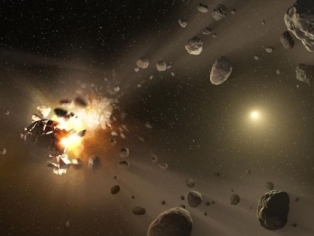
"Morbidelli and Scott Jay Kenyon have also suggested that Sedna did not originate in the Solar System, but was captured by the Sun from a passing extrasolar planetary system, specifically that of a brown dwarf about 1/20th the mass of the Sun (4,5)." (1)
If anyone doubted the potential for a major Planet X body then this above summary from Wikipedia regarding the work of several serious teams of astronomers should give them pause for thought. As I've often said, the existence of a sizeable Planet X is taken a lot more seriously by many astronomers than most members of the general public. It's just that most people equate Planet X with an in-coming, imminent threat to Earth, rather than a consideration of what may yet be discovered in the immense, unexplored regions of space beyond Neptune.

The 2004 papers by Morbidelli and Levison (4) and
Scott Jay Kenyon et al (5) has recently been tested by computer
simulations by a team from Leiden Observatory
and Cornell University (13,14). They churned out some
possible solutions, assuming that Sedna was captured by the Sun from a
passing star, which was part of the Sun's early birthing cluster.
This detailed work was carried out by applying a fairly narrow series of
parameters, both of the usurper star's mass and the distance of its
closest approach to the Sun:
“We constrained the parent
star of Sedna to have between one and two times the mass of the Sun and
its closest approach to be 200-400 AUs,” Dr. Lucie Jilkova of Leiden
Observatory told Universe Today. “Such a close encounter probably
happened while the Sun was still a member of its birth star cluster — a
family of about 1,000 stars, so called solar siblings, born at the same
time relatively close together — which was about 4 billion years ago.”
(15) The team managed to find a fit, although it is
unclear as to whether these self-same parameters also apply themselves
successfully to other extended SDOs, like 2000 CR105
and 2012 VP
Written by Andy Lloyd,
15th August 2015
References:
1)
"90377 Sedna"wikipedia.org/wiki/90377_Sedna
2) A. Lloyd "Sedna: A Clue to Nibiru" 15 March-21 April 2005
3) "Transneptunian Object 90377 Sedna (formerly known as 2003 VB12)". The Planetary Society. Archived from the original on 25 November 2009.
4) Alessandro Morbidelli & Harold F. Levison "Scenarios for the Origin of the Orbits of the Trans-Neptunian Objects 2000 CR105 and 2003 VB12 (Sedna)". The Astronomical Journal, 128: (5), 2564–2576
5) Scott J. Kenyon, Benjamin C. Bromley "Stellar encounters as the origin of distant Solar System objects in highly eccentric orbits", Nature, 432: (7017) 598–602. arXiv:astro-ph/0412030
6) Rodney S. Gomes, John J. Matese, and Jack J. Lissauer "A distant planetary-mass solar companion may have produced distant detached objects", Icarus, 184 (2): 589–601, October 2006
7) P. S. Lykawka and T. Mukai "An Outer Planet Beyond Pluto and the Origin of the Trans-Neptunian Belt Architecture", The Astronomical Journal, 135 (4): 1161, 2008
8) Megan Schwamb "Searching for Sedna's Sisters: Exploring the inner Oort cloud" Cal Tech, 2007, archived from the original (PDF) 2013
9) Staff Writers "Evidence Mounts For Companion Star To Our Sun" 25 April 2006.
10) J. G. Hills "Dynamical constraints on the mass and perihelion distance of Nemesis and the stability of its orbit". Nature 311 (5987): 636–638, 1984
11) "Nemesis is a myth", Max Planck Institute, 1 August 2011, see
12) John J. Matese, Daniel P. Whitmire and Jack J. Lissauer "A Widebinary Solar Companion as a Possible Origin of Sedna-like Objects", Earth, Moon, and Planets, 97 (3–4): 459–470, 2006
13) Lucie Jilkova et al. "How Sedna and family were captured in a close encounter with a solar sibling", Monthly Notices of the Royal Astronomical Society, 453 (3): 3157–3162, 01 November 2015,
14) David Dickinson "Stealing Sedna" 7 August 2015
15) David Dickinson "Stealing Sedna" 6 August 2015 with thanks to Lee
16) Andy Lloyd "Orbital Considerations for Planet X" 27 February 2002
17) Carnegie Institution for Science "A New Object at the Edge of our Solar System Discovered" 26 March 2014
18) Andy Lloyd "New Object in Outer Solar System Hints at Planet X" 27 March 2014
andylloyd.org/darkstarblog13.htm
The Origins of the Kuiper Belt 'Kernel'
Academic work is about to be published in The Astronomical Journal about the mysterious origins of a cluster of objects in the Kuiper Belt known as the 'kernel' (1,2). This collection of tightly-bound objects moves in the plane of the ecliptic like the planets, but very much unlike the more unpredictable spread of the other Kuiper Belt Objects. Does their distinctive behaviour point to a particular incident in the early system which essentially shepherded them, en masse, to their current location?
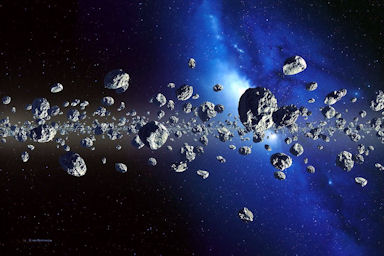
Image Credit: Detlev Van Ravenswaay/Science Photo Library
Attempts to model the orbits of the kernel objects using collisions between larger Kuiper Belt Objects proved fruitless. Instead, the structural nature of the kernel objects' orbits implies some kind of primitive resonance with the planet Neptune, which early on had migrated across the solar system.
"The kernel started life in Neptune’s gravitational clutches, but further from the sun. The planet slowly wandered outwards, and pushed these icy objects with it. But, when it was 4.2 billion kilometres from our star, Neptune shifted its orbit suddenly, probably because of a close encounter with another planet. The kernel couldn’t keep up: the objects escaped Neptune and remained together, exactly where they were at the time." (3)
This is quite a complex idea, comprising of a chain of events each of which could have produced any number of different outcomes if just slightly altered. Not an easy thing to model at all. The missing ingredient was a missing fifth gas/ice giant. A long series of super-computer simulations by David Nesvorny of the Southwest Research Institute at Boulder, Colorado finally provided a workable scenario - one where a migrating Neptune was given an extra nudge by an other sizeable, and mysterious planet:
"No one knows what became of the missing planet, but when Nesvorny developed a previous model in 2011 (4), he found that the best way to wind up with the present-day orbital configuration of the solar system was to include a fifth giant planet. The mystery giant was most likely ejected permanently from the solar system after disrupting the original orbits of the surviving planets, Nesvorny says—a casualty of its gravitational wrestling match. But back in 2011, he never thought he would find evidence of the planet’s possible existence. “The Kuiper belt is the clue,” Nesvorny says. “You see the structures there, and you try to figure out what kind of evolution would fit those structures.”" (5)
All good stuff. However...
It's interesting to compare this finding with the one featured in the article above about Sedna. Unusual characteristics of the outer solar system require solutions, and computer models are applied to the problem building into them parameters which reflect what the researchers think is the most likely explanation. Hundreds of simulations are carried out until the right solution is found, and then shown to the world as proof that the initial scientific hunch was correct.
Yet, if you look at these two theories, they can't both be correct. You can't have had both the perturbing effect of a passing Sun-like star, as well as a situation where Neptune was nudged by a rogue planet into lurching backwards, sending clusters of resonant asteroids into the Kuiper Belt. If both of these disparate scenarios occurred in the early solar system, then each would have massively affected the careful computerised unpicking of the other.
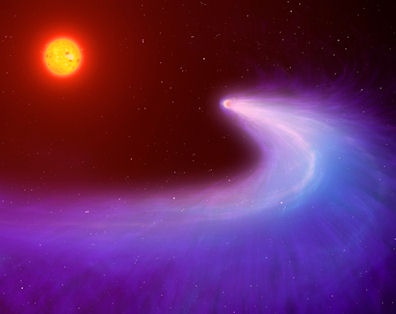
Yet, it seems more likely to me that the two scenarios are linked. The rogue giant planet which nudged Neptune, tipping its resonant objects back into the outer solar system, also had a perturbing effect upon the objects further out which became the extended scattered disk objects, like Sedna. One can tie these together by simply imagining a rogue object moving through a highly elongated, elliptical orbit, beginning somewhere close to the Kuiper Belt and ending somewhere way out among the comets.
It's also interesting to note that explanations abound about why the inner solar system is configured the way it is, compared to other exo-planetary systems (which we are beginning to understand in better detail). Some scenarios require one or more of the other giant planets in the solar system wreaking havoc early on, e.g. Jupiter (6).
So, now we have a rogue planet which causes problems in the inner, middle and outer solar system. Yet, no one in the scientific community or scientific media seems to want to join all of this together. Why not? Because the obvious implication is that this rogue giant planet is very much in line with that deeply heretical notion, Nibiru. Instead, in article after article that I've read recently, the reader is 'reassured' that no such nonsense need be considered. By breaking down the solar system into little zones, the bigger picture can be ignored, it seems.
But not here...
Written by Andy Lloyd, 15th August 2015
References:
1)
David Nesvorny "Jumping Neptune Can Explain the Kuiper Belt Kernel" 19 June 20152) David Nesvorný "Jumping Neptune Can Explain the Kuiper Belt Kernel" The Astronomical Journal, 150: 68, 2015,
3) Sarah Scoles "Neptune’s sudden jolt could explain weird ring in Kuiper belt" 29 July 2015
4) David Nesvorny "Young Solar System's Fifth Giant Planet?" The Astrophysical Journal Letters, 742 (2), Sept 2011
5) Nola Taylor Redd "Our early solar system may have been home to a fifth giant planet" 11 August 2015 with thanks to Lee
6) Janet Fang "Jupiter Was A Wrecking Ball That Smashed Through Early Solar System" 24 March 2015
Earth's Deep Water 'Different' from Ocean Water
I've had a
long term interest in the potential for plain old water to be the key to
unlocking the existence of Nibiru (1,2). Sounds far-fetched? As it
turns out, water can tell us a lot about the origins of various bodies in the
solar system. We can determine subtle differences in these waters through
chemical analysis of how much hydrogen and its heavier equivalent deuterium are
contained in the water. This deuterium/hydrogen (D/H) ratio varies
considerably. Scientists have been pondering whether, say, the D/H ratio
in the earth's oceans are similar to that of water on comets, or on asteroids
(3), and even on Mars (4).
An underlying assumption of all of this is that the water on
Earth is equivalent throughout. That the all important D/H ratio is
essentially static across the globe. Of course, global oceanic water has
been mixed up thoroughly, and even the impact of a large icy comet onto the
surface of the earth will deliver water whose different ratio of deuterium will
quickly be absorbed into whole without trace. What, though, of the waters
that find their way deeper into the earth's mantle? What of waters that
have been trapped below the surface of the Earth in deep pockets, underground
reservoirs and even subsurface oceans? Perhaps these virgin waters, if
they can be found and analysed, might give us a picture of what the Earth's
waters comprised of when the planet formed, long before comets delivered our
oceans (if indeed they did - this assumes the reality of the 'late veneer'
theory (5,6))? Is it possible to differentiate these waters anyway, or do
on-going geo-physical processes within the earth transport waters through the
mantle over geological time periods, essentially making the distinction moot? Well, these waters may have just got a bit muddier, as it
turns out that there may not be uniformity between deep water and oceanic water
after all: "Meech and colleagues are hunting
for primordial sources of water on Earth. They think they’ve found it near hot
spots, such as the Hawaiian Islands, where molten rock from the mantle wells up
into volcanoes. What they find is a bit troubling: The deep water is chemically
different from that in the oceans, which means researchers are likely using the
wrong D/H ratio for Earth." (7)
Oops. If we're trying to establish how the water on Earth relates to that elsewhere, then the possibility ('fact' may be too strong a word at this stage) that it varies between ocean and mantle deposits creates an all-new degree of complexity. The scientist who has provided this new finding at conference clarifies the issues regarding how Earth got its water quite well:
"Given that many disk models show that Earth formed inside the water-ice snow line of our solar system, understanding how the inner solar system received its water is important for understanding the potential for other planetary systems to host habitable worlds. Boundaries for the timing of the water delivery are constrained by cosmochemistry and geochemistry. Possible scenarios for the delivery of water to the inner solar system include adsorption on (sic) dust from protoplanetary disk gas, chemical reactions on the early earth, and delivery from planetesimals forming outside the water-ice snow line." (8)
In all of this, the underlying assumption of Earth's stationary positioning in the solar system is never questioned. Neptune may migrate. Jupiter may migrate (see above). But never the Earth. I strongly suspect that the Earth began its life beyond the so-called snow-line. The implication of this is incredibly important. If Earth began its life around the position of the asteroid belt, then it began life with its own internal waters.
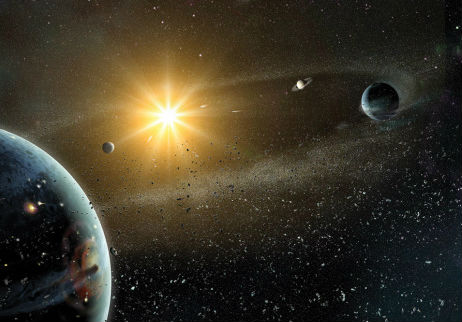
It did not need the deep waters to be delivered by asteroids, or be created by chemical reactions, or any other such exotic hypotheses. It was simply here all along. So, if waters found deep within the Earth's mantle are different from the oceans in terms of their D/H ratio, then it's likely that these deep primordial waters were formed directly from the protoplanetary disk, along with the rest of the Earth, located somewhere between Mars and Jupiter. Along with the asteroids. And if the Earth's oceans are different, as they seem to be, then it's because those surface waters were delivered later from elsewhere.
On the down side, although this seems straightforward enough, the increasing complexity of the variation of waters across the solar system means that this hypothesis is, unfortunately, no easier to prove than any other.
Written by Andy Lloyd, 15th August 2015 References: 1)
2) Andy Lloyd "The Great Water Conundrum 2" 2011-2013
3) Andy Lloyd "The Asteroid/Comet Identity Crisis" 20 December 2014
andylloyd.org/darkstarblog21.htm
4) Andy Lloyd "The Curious Waters of Mars" 17 April 2015
andylloyd.org/darkstarblog25.htm
5) C.-L. Chou "Fractionation of siderophile elements in the Earth’s upper mantle" Proc. Lunar Sci. Conf. 9, 219–230, 1978
6) Francis Albarede et al. "Asteroidal impacts and the origin of terrestrial and lunar volatiles" Icarus, 222, 44-52, 2013
7) Christopher Crockett "Quest to trace origin of Earth’s water is ‘a complete mess’" 5 August 2015 with thanks to John
8) Karen Meech "Origins of water in the solar system leading to habitable worlds" International Astronomical Union 29th General Assembly, Honolulu, Hawaii, 4 August 2015,
The Mystery of the Winged Disk Star
Planet X controversy swirls around a star in the constellation Taurus whose appearance mirrors that of the fabled Winged Disk. Although the object in question is quite clearly represented on various well-established sky-maps (1), it has been claimed that the area containing it was not available on Google Sky. Instead, it has been controversially claimed, there was just a blacked out zone of mystery, fuelling claims that Planet X was being hidden from view by the government and its agencies (2). Whatever the truth of this, the area in question is available on Google Sky now (image, right), in its somewhat rendered, false colour format.
So, is this Nibiru?
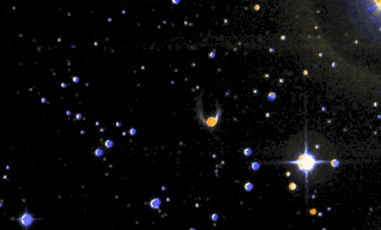
Image credit: Google Sky/DSS Consortium, SDSS, NASA/ESA
The strongest counter-argument against the more speculative Planet X theory for this object is that its winged appearance is merely a 'reflection nebula' (3). This post by 'Dr Astro' does a pretty tough debunking job of this controversy, complete with some helpful archived data about this star:
"Here it is from a picture from 1951
Here it is from a picture taken by the same telescope in the 1990s:
Same surrounding stars, it hasn't moved in all that time. My alma mater has the 1951 picture at their observatory so I can personally verify that shit and take a new picture of the same nebula and star if you want. It's just a reflection nebula around a t tauri star, a young pre-main sequence star surrounded by the remnants of the cloud it was birthed from.
simbad.u-strasbg.fr image" (4)
These active young proto-stars shed material at an alarming rate, creating extremely fast-moving mass ejections which shine brightly in the youthful light of the parent star. The spectacular time-lapse imagery to the right, captured by the Hubble Space telescope, shows the process in motion (5). T-Tauri stars often blast two opposing jets out simultaneously (a non-random effect whose shape may be caused by the star's magnetic field, or obstruction by debris fields/the star's proto-planetary disk) and it is thought that this is what is happening with the controversial winged star in Taurus.
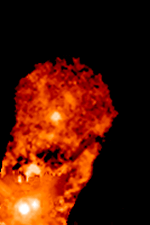
Image credit: John Krist (STScI), Karl Stapelfeldt (NASA JPL), Jeff Hester (Arizona State University), Chris Burrows (ESA/STScI)
I'd like to add the following argument. Obviously, a sub-brown dwarf Planet X object would not behave in the same way as a T-Tauri star. Instead, as we have seen above, the Winged Disk effect for a Planet X object is most likely to be due to red aurorae, excited by the solar wind and strong magnetic field of the Sun. For such a scenario to work, the Planet X object would need to be sailing pretty close to the wind. In other words, the Winged Disk 'Nibiru' effect would occur when Planet X moves through perihelion.
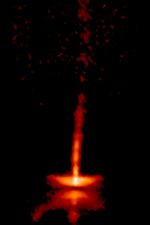
Image credit: Alan Watson (Universidad Nacional Autonoma de Mexico, Mexico), Karl Stapelfeldt (NASA JPL), John Krist (STScI)
Of course, many advocates of Planet X believe that that it exactly what is happening right now. However, as Dr Astro helpfully reveals, the winged Taurean star causing all this fuss has not moved substantially across the sky in 60 years. Perhaps it moves towards us, or away from us to a greater or lesser extent, but without a half-decent lateral movement across the sky it is most definitely not moving through a perihelion passage. Therefore, there would be no Winged Disk effect to see anyway, as it would have to lie way out in the outer solar system. So, either you have a Winged Disk 'star' with a substantive lateral movement across the sky, or you have a dim, unadorned object way out there somewhere. QED, this is not Nibiru.
Written by Andy Lloyd,
27 August 2015
References:
1)
A. Lloyd "Could this be Nibiru?" 28 June 2015andylloyd.org/darkstarblog27.htm
2) Shepard Ambellas "Planet X just revealed by Google Sky? Black swath gone, ‘winged disk’ visible" 23 June 2015 with thanks to Barry
3) "GN 05.39.2 -- Reflection Nebula"
4) "Dr Astro", in reply to "After being censored for 6 years, Google Sky finally reveals what was behind the BIG BLACK BOX!" 11 June 2015 with thanks to Barry
godlikeproductions.com/forum message
5) "Stellar Birth and Middle Age"
You
can keep informed of updates
by following me on Twitter:
Or like my Facebook Page:
https://www.facebook.com/darkstarandylloyd

![]()